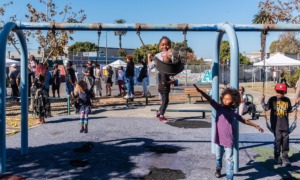 Safety and belonging are the two basics that establish our emotional resources and well-being. Safety and belonging are also the two aspects of foster life that are constantly up in the air. This is further problematic now with what is known as “Generation K”: 13- to 20-year-olds.
Safety and belonging are the two basics that establish our emotional resources and well-being. Safety and belonging are also the two aspects of foster life that are constantly up in the air. This is further problematic now with what is known as “Generation K”: 13- to 20-year-olds.
Economist and author Noreena Hertz created the name from that generation’s “Hunger Games” icon, Katniss Everdeen, after surveying 1,000 British and American girls. Hertz says their motto is: “I connect, therefore I am.” This generation grew up with the iPhone and Facebook.
Unlike the millennials before them, this generation has a huge distrust of institutions — governments and corporations. They watched the recession and the rise of the terrorists. The world is not a safe place, nor is it to be trusted.
“Only one in 10 trusts the government to do the right thing — half the percentage of older millennials,” Hertz wrote. Furthermore, only 4 percent trust corporations, 30 percent are unsure or do not want to be married, 35 percent are unsure or do not want to have children and 90 percent consider it important to have a high-paying career.
They admire Katniss, who insists on what is right and fair. This generation is not about conformity but rather about “celebrating differences.”
In fact, 86 percent of Generation K girls are worried about getting a job, and 77 percent are worried about getting into debt. They are very worried about their future. Constant worry creates anxiety. This generation is more sober than the previous — less alcohol and drugs. However, 22 percent have considered suicide.
What about the boys? Again, the issue is connection, but it is with the screen. Philip Zimbardo and Nikita Duncan, researchers at Stanford University, found that the average boy watches 50 porn clips a week. By the time the boys are 21, they have played more than 10,000 video games — mostly in isolation, they found. In fact, these are “arousal” addictions, and their brains are being rewired for constant arousal, novelty and excitement. The boys are actually preferring the isolation — i.e., “I am not even going to try to belong.” They are risk-averse.
The basis of all emotional wellness is safety and belonging. For this generation, the external environment is harsh, unpredictable and unsafe. Terrorism, Facebook envy and cyberbullying are all a part of the daily reality. The school reality has become harsher — state assessment (you make it or you don’t) and zero tolerance in discipline. You are often bullied in school and out of school — in person and via social media. The external world becomes basically unsafe.
John Bowlby found in his research on bonding and attachment that when you see yourself as belonging and in a safe environment, you are emotionally secure. When you find yourself in a situation where the external environment is safe but you are “bad,” then you become very anxious and insecure emotionally. If you are in an environment that you perceive to be unsafe, but you view yourself as “good,” then you become avoidant and insecure. If you are in an environment that you view as unsafe, and you view yourself as “bad,” then it is survival of the fittest.
For this generation, the external environment is not safe. So what you strive for is connection or belonging. But if you cannot belong, then you respond with anxiety (cutting or suicide attempts) or avoidant behavior (screen addictions).
For foster youth, this issue of safety and belonging has been multiplied — particularly for this generation. As a youth worker or foster parent, you cannot change the external realities of terrorism and economic cycles. But you can address the belonging/connection issue.
For many foster children, bonding and attachment to the caregiver did not occur, so anxiety and avoidant behavior are a given, and sometimes it is survival of the fittest. It is very important to help them establish connections.
Volunteering is good for foster children. In the research, volunteering does more to empower one than many other activities. It brings value, connection and meaning to one’s life. I strongly recommend that each foster child get involved in some volunteer activity of their choice. When all the key individuals in your life have left, finding connection is very hard. Volunteering is one way to counter this.
Working for a cause is another way to create connections. In fact, in the research, having a cause in your life makes people much happier.
Ruby K. Payne, Ph.D., is the founder of aha! Process and an author, speaker, publisher and career educator. She is recognized internationally for “A Framework for Understanding Poverty,” her foundational book and workshop.






























